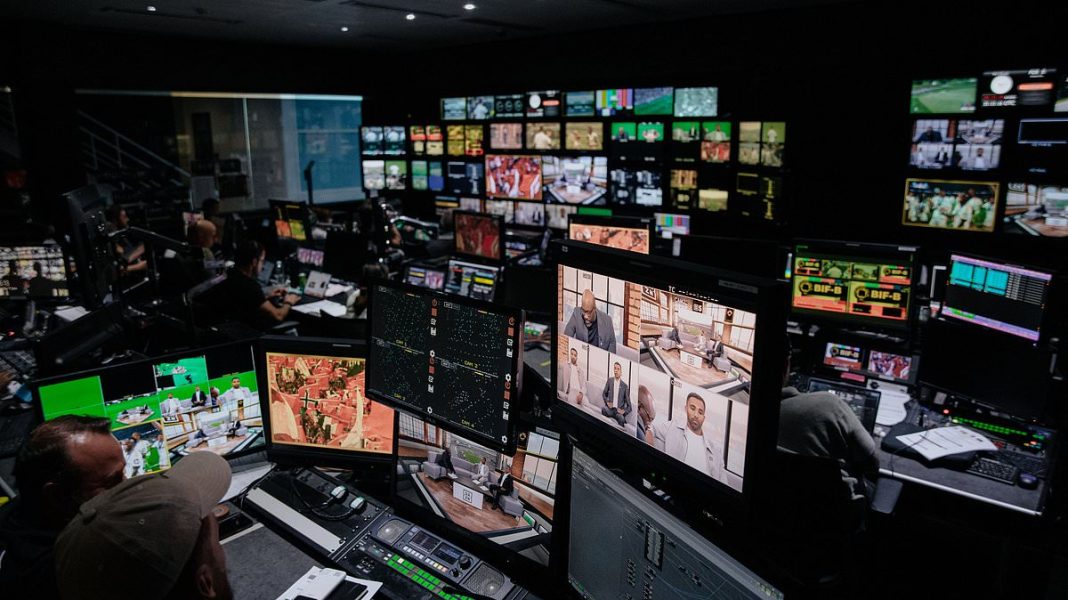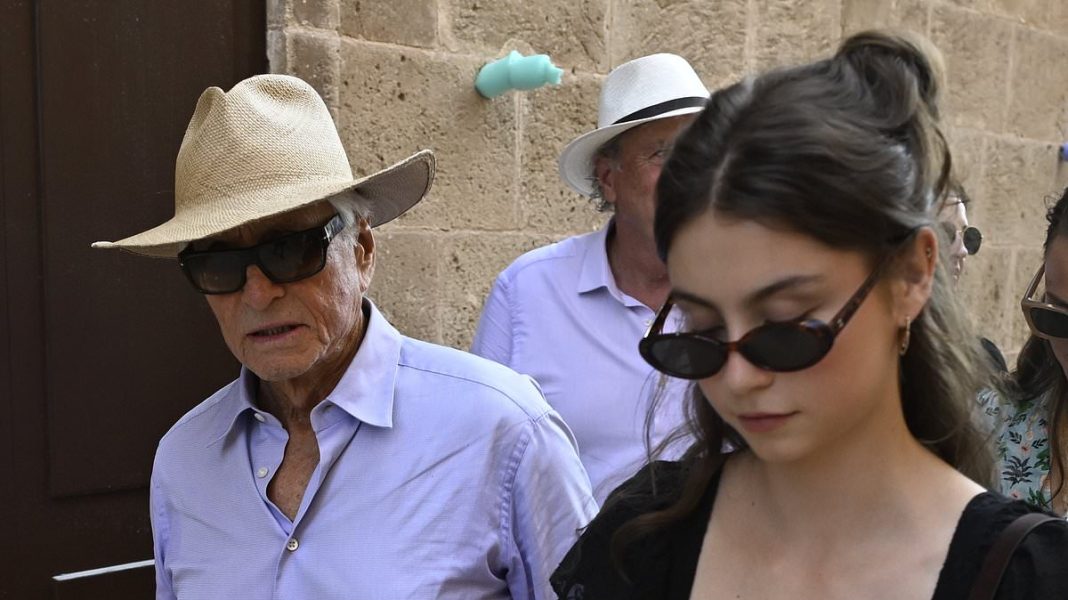- Mail Sport was invited to DAZN’s Global English Production Hub to get an insight
- They spoke of rearing the next generation of pundits and how AI is being used
- Watch every Club World Cup match free on DAZN. Sign Up Now
DAZN’s broadcast nerve centre is buzzing with activity, but the hive depends on one key ingredient to sustain its energy.
‘The whole production is powered by chocolate,’ says Mail Sport’s tour guide as a flustered runner rushes past with a trolley full of goodies. No Twix bars for us, sadly.
We’re here at DAZN’s Global English production hub, hosted at IMG’s studios in a west London outpost, to learn more about their 24/7 operation for the Club World Cup, one involving hundreds of hands on deck and millions of eyeballs globally.
In some ways, it’s a glimpse at the future of sports coverage. DAZN are seemingly here to stay, spreading their tendrils across boxing, golf, football, and other sports since starting broadcasting in 2015 and now being watched in more than 200 nations.
Big money is swilling around, too. In December, DAZN paid $1billion (£736million) for the rights to stream the FIFA Club World Cup, in the same month that Saudi company SURJ Sports Investment bought a stake in them for the same figure, and the same month that Saudi Arabia was named the 2034 World Cup host.
In that time, and with that funding, DAZN have assembled a huge operation. Their team, quickly put together for the tournament, comprises experience across World Cups, Champions Leagues, and other major sporting events. It’s a well-oiled machine.
‘If I explain to anyone in this industry what we’ve achieved in this timeframe, they think I’m mad,’ says Simon Corney, DAZN’s senior executive producer for the tournament. ‘I’ve never worked on anything like this.’
DAZN and IMG believe this revamped Club World Cup is one worth watching – and a treasure chest of engagement opportunities.
There’s a reporter, camera operator, and producer stationed with all 32 teams and their content production goes far beyond simply live broadcasting.
They’ve produced a series called The 32, covering quirky features relating to all the clubs involved, including on Monterrey’s celebrity mascot Monty, Seattle Sounders’ ‘rabid’ in-house band, and Manchester City and New York City’s initiative building pitches across NYC.
Another highlights show, The Press, feels like Match of the Day. Recapping all the day’s games with an expert panel, the structure and graphics give a similar feel to the BBC favourite, but there are ways in which it is unique.
The show is refreshing in its use of a tactics board to boost the analysis, while the pundits will often respond to questions submitted by viewers on social media.
Boosting audience interactivity feels like a major value for DAZN in their project. The app features a ‘fanzone’ feature where supporters from across the world can interact over text while watching a game – not that the submissions to the chat are always the most edifying.
Their broadcasts are going out in 15 languages, with breaks across the world timed simultaneously to the second and counted in by one worker with a particularly high-pressure role.
While available pretty much worldwide, DAZN considers its core markets to be in the UK, the US, Germany, Italy, Japan, Spain, Canada, Belgium, Portugal, and Taiwan, and offers particularly tailored content to these nations.
On matchday, around 35 cameras are present at each stadium. Out in the United States, eight commentary pairs are staying together – alongside a pitchside reporter – in the belief that living in close quarters build better on-screen rapport.
For now, the analysis and punditry – involving figures such as Ronaldo Nazario, John Obi Mikel, and Shay Given – is being done at IMG’s Stockley Park base. However, from the quarter-finals onwards, all punditry will be done on-site in the United States to increase the production value and better capture the flavour of the atmospheres.
DAZN are also keen to blood the next generation of pundits. Newcastle striker Callum Wilson, new to the punditry game, has been been brought on board and meets Mail Sport on Wednesday before Manchester City’s 2-0 win over Wydad AC.
His prospective bosses were impressed with how he had come across in interviews and on social media.
‘The first thing you watch, you see he’s got something,’ says Corney. ‘He’s not afraid to speak his mind. He’s calm, collected, and has played at the highest level.
‘There’s nothing better than having a current Premier League footballer on your talent roster because they’re just talking in the moment. You’ve got to be refreshing the talent pool – you don’t want the same old heads. You need a blend.’
And why did Wilson choose the Club World Cup to make his punditry bow?
‘It’s just the excitement of it, teams playing against each other for the first time in their history. There’s obviously the financial rewards for the smaller clubs that are involved and a platform for players to showcase their talent. A lot of players want to play in Europe eventually so it’s a great opportunity for them.
‘As someone who is watching from afar, it’s enjoyable. It was crazy to cover the Boca Juniors-Benfica game, then you see the 10-0 with Bayern Munich and Auckland City, getting their name out there.
‘It reminds me of FIFA, you know when you play against random selection teams and all of a sudden it’s random matches you’re never going to have, but in a competitive environment.’
On Mail Sport’s tour, DAZN emphasise the need for innovation – they want this to be a broadcast experience unlike any other.
The jury is still out on that front, and DAZN do not really answer when Mail Sport asks what innovations they are proud of, but broadcasters are often beholden to the authorities. One new feature this time is the referee cam, mounted on the ref’s ear, which gives a unique angle for replays, but that required approval from the International Football Association Board.
Half-time interviews bring fans even closer to the action, and are more common in the American sports market, though there’s a debate to be had around whether sportspeople should have to give that time up when they’re ‘in the zone’.
DAZN have done a good job and their level of care shows. We ask Corney if they’ve looked to implement AI into their works process, but he gives an impassioned defence of using people for the important tasks.
Highlights packages, for example, are still cut with a human eye. ‘I’m not prepared to have our name and reputation next to a set of rubbish highlights,’ says Corney.
‘If you get an AI software to cut highlights, you need to have a human check it hasn’t ballsed up anyway. So you might as well have a human do it.There’s no substitute.’
They do lean on AI for some tasks, though. All interviews are translated using a software called Limecraft, which uses Automatic Speech Recognition (ASR) and Neural Machine Translation (NMT) to subtitle them in the languages needed for their global audience.
Arguably the biggest task is overhauling the public perception of a tournament which, for European teams, has typically been a procession. Only 3,412 fans attended Mamelodi Sundowns vs Ulsan Hyundai – quite far from Gianni Infantino’s vision of ’63 Super Bowls in one month’. Even Chelsea only drew 22,137 against LAFF, leaving almost 50,000 seats empty.
Ultimately, the level of appetite for the Club World Cup is a question only the audience can answer. DAZN and IMG have done all they can to appeal – there’s even a package of Lionel Messi highlights for each game, right from his arrival to his exit, for the particularly obsessed viewers.
It’s hard to see how their rivals in Sky Sports, TNT Sports, or Amazon would have done a much better job.






